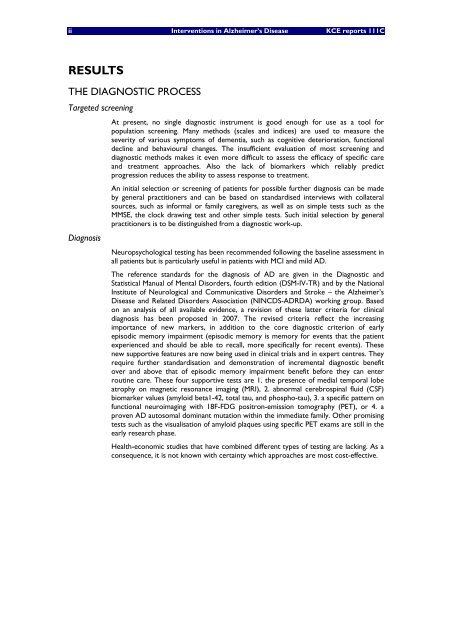Download the full report (112 p.) - KCE
Download the full report (112 p.) - KCE
Download the full report (112 p.) - KCE
Create successful ePaper yourself
Turn your PDF publications into a flip-book with our unique Google optimized e-Paper software.
ii Interventions in Alzheimer’s Disease <strong>KCE</strong> <strong>report</strong>s 111C<br />
RESULTS<br />
THE DIAGNOSTIC PROCESS<br />
Targeted screening<br />
Diagnosis<br />
At present, no single diagnostic instrument is good enough for use as a tool for<br />
population screening. Many methods (scales and indices) are used to measure <strong>the</strong><br />
severity of various symptoms of dementia, such as cognitive deterioration, functional<br />
decline and behavioural changes. The insufficient evaluation of most screening and<br />
diagnostic methods makes it even more difficult to assess <strong>the</strong> efficacy of specific care<br />
and treatment approaches. Also <strong>the</strong> lack of biomarkers which reliably predict<br />
progression reduces <strong>the</strong> ability to assess response to treatment.<br />
An initial selection or screening of patients for possible fur<strong>the</strong>r diagnosis can be made<br />
by general practitioners and can be based on standardised interviews with collateral<br />
sources, such as informal or family caregivers, as well as on simple tests such as <strong>the</strong><br />
MMSE, <strong>the</strong> clock drawing test and o<strong>the</strong>r simple tests. Such initial selection by general<br />
practitioners is to be distinguished from a diagnostic work-up.<br />
Neuropsychological testing has been recommended following <strong>the</strong> baseline assessment in<br />
all patients but is particularly useful in patients with MCI and mild AD.<br />
The reference standards for <strong>the</strong> diagnosis of AD are given in <strong>the</strong> Diagnostic and<br />
Statistical Manual of Mental Disorders, fourth edition (DSM-IV-TR) and by <strong>the</strong> National<br />
Institute of Neurological and Communicative Disorders and Stroke – <strong>the</strong> Alzheimer’s<br />
Disease and Related Disorders Association (NINCDS-ADRDA) working group. Based<br />
on an analysis of all available evidence, a revision of <strong>the</strong>se latter criteria for clinical<br />
diagnosis has been proposed in 2007. The revised criteria reflect <strong>the</strong> increasing<br />
importance of new markers, in addition to <strong>the</strong> core diagnostic criterion of early<br />
episodic memory impairment (episodic memory is memory for events that <strong>the</strong> patient<br />
experienced and should be able to recall, more specifically for recent events). These<br />
new supportive features are now being used in clinical trials and in expert centres. They<br />
require fur<strong>the</strong>r standardisation and demonstration of incremental diagnostic benefit<br />
over and above that of episodic memory impairment benefit before <strong>the</strong>y can enter<br />
routine care. These four supportive tests are 1. <strong>the</strong> presence of medial temporal lobe<br />
atrophy on magnetic resonance imaging (MRI), 2. abnormal cerebrospinal fluid (CSF)<br />
biomarker values (amyloid beta1-42, total tau, and phospho-tau), 3. a specific pattern on<br />
functional neuroimaging with 18F-FDG positron-emission tomography (PET), or 4. a<br />
proven AD autosomal dominant mutation within <strong>the</strong> immediate family. O<strong>the</strong>r promising<br />
tests such as <strong>the</strong> visualisation of amyloid plaques using specific PET exams are still in <strong>the</strong><br />
early research phase.<br />
Health-economic studies that have combined different types of testing are lacking. As a<br />
consequence, it is not known with certainty which approaches are most cost-effective.

















